Optimization of Green Multimodal Transport Schemes Considering Order Consolidation under Uncertainty Conditions
Abstract
:1. Introduction
2. Mathematical Modeling
2.1. Problem Description
- For the same order, goods should not be split and should only use one mode of transportation between any two nodes.
- Goods trans-shipment should only occur at nodes, and each node should only have one trans-shipment.
- Goods should only select one transportation route and one mode of transportation between two nodes.
- The in-transit transportation speed of each mode of transportation is constant and known.
- After completing trans-shipment at the current node, goods are transported to the next node by the next available schedule of the selected transportation mode.
- In this paper, only flight and high-speed railway time delays are considered, excluding road time delays.
- In-transit and trans-shipment delay times are random variables following a log-normal distribution.
2.2. Order Consolidation Strategy
2.2.1. Primary Task Selection Strategy
2.2.2. Order Consolidation Conditions
- Time Coordination Constraint: After order consolidation, the transportation plan must satisfy the time coordination constraint, which means the sub-task must arrive at the consolidation point and complete the trans-shipment before the primary task departs from that point.
- Capacity Constraint: After order consolidation, the transportation plan must satisfy the capacity constraint. The consolidation may cause cargo to concentrate in certain advantageous routes, potentially leading to capacity issues.
- Objective Function Optimization: After order consolidation, the value of the objective function must be better than before consolidation.
2.2.3. Order Consolidation Scenarios
- Scenario 1: Sub-orders and master orders have the same origin and destination. In this scenario, the sub-order is directly combined with the main order for transportation, and the sub-order has the same transportation path and transportation mode as the main order. The specific combined transportation method is shown in Figure 3.
- Scenario 2: Sub-orders and main orders have the same origin but different destinations. In this scenario, the sub-order and the main order are first combined and transported from the origin O to the nearest city node I of the destination of the sub-order, and then they are transported separately from that node to their destinations. The specific combined transportation method is shown in Figure 4.

- Scenario 3: Orders have different origins but the sub-order and the main order have the same destination. In this scenario, the sub-order is first transported from its origin to the consolidation city node I on the transportation route of the main order. This node should be the closest city node to the origin of the sub-order that satisfies the time coordination constraint. From this node, the sub-order is consolidated with the main order and they are transported together to the common destination D. The specific consolidation method is illustrated in Figure 5.

- Scenario 4: The sub-order and main order have different origins and destinations. In this scenario, the sub-order is first transported from its origin, O1, to the consolidation city node I on the main order’s transportation route (this consolidation node should be the closest city node to the origin of the sub-order that satisfies the time coordination constraint). Then, the sub-order is consolidated with the main order and they are transported together to the separation point, K (the separation city node should be the closest city node to the destination of the sub-order). From this node, the sub-order is transported separately to its final destination. The specific consolidation method is illustrated in Figure 6.
2.3. Model Construction
2.3.1. Symbol Description
2.3.2. Objective Functions
- 1.
- Transportation cost
- 2.
- Transportation time
- 3.
- Carbon emissions
2.3.3. Constraints
2.3.4. Deterministic Transformation of the Model Based on Fuzzy Credibility
3. Solution Algorithm Design
3.1. Basic Genetic Algorithm
- 1.
- Coding and Decoding
- 2.
- Population Initialization
- Step 1: Generate the adjacency matrix and the matrix of transportation modes existing between any two nodes based on the multimodal transport network. For the adjacency matrix, nodes are connected if there is a transportation mode between two nodes.
- Step 2: Generate legitimate transportation paths based on the topological sorting rules combined with the adjacency matrix . The node numbers in the path are used as the coding for chromosome segment one. Then, randomly select any transportation mode between nodes from the matrix to generate chromosome segment two, thus obtaining the single-order transportation plan chromosome. This process is repeated until the desired number of single-order transport plan chromosomes is generated, and they are combined to obtain the individuals of the initial population.
- Step 3: Stop if the population size meets the requirement; otherwise, return to step 2.
- 3.
- Selection Operation
- 4.
- Crossover Operation
- 5.
- Mutation Operation
3.2. Improved Genetic Algorithm Based on Stochastic Simulation Technique
- 1.
- Objective Function Value Calculation
- 2.
- Fitness Values and Constraint Handling
- Step 1: Input the individual, assuming there are p orders to be decided.
- Step 2: Uniformly generate N samples based on the delay time probability distribution function.
- Step 3: Calculate the transportation time of each order in the individual under each sample.
- Step 4: Count the number of samples where the transportation time of each order is within the delivery time window.
- Step 5: Calculate the punctuality rate of each order in the individual, .
- Step 6: Calculate the individual’s punctuality rate . If the punctuality rate constraint is not met, set the fitness to zero; otherwise, .
3.3. Improved Genetic Algorithm Based on Task-Riding Method
3.4. Algorithm Flowchart
4. Case Analysis
4.1. Case Description and Parameter Setting
4.2. Results Analysis of Scheme Optimization with and without Order Consolidation
4.3. Impact of Customer Preferences on Order Consolidation
4.4. Analysis of Order Consolidation Results under Different Scenarios
5. Conclusions
Author Contributions
Funding
Institutional Review Board Statement
Informed Consent Statement
Data Availability Statement
Conflicts of Interest
References
- Ralf, E.; Jan, P.M.; Johannes, R. Tactical network planning and design in multimodal transportation—A systematic literature review. Res. Transp. Bus. Manag. 2020, 35, 100462. [Google Scholar]
- Delbart, T.; Molenbruch, Y.; Braekers, K.; Caris, A. Uncertainty in intermodal and synchromodal transport: Review and future research directions. Sustainability 2021, 13, 3980. [Google Scholar] [CrossRef]
- Lu, Y.P.; Chen, F.; Zhang, P. Multi-objective Optimization of Multimodal Transportation Route Problem Under Uncertainty. Eng. Let. 2022, 30, 1640–1646. [Google Scholar]
- Xu, Z.; Jin, F.Y.; Yuan, X.M.; Zhang, H.Y. Low-Carbon Multimodal Transportation Path Optimization under Dual Uncertainty of Demand and Time. Sustainability 2021, 13, 8180. [Google Scholar] [CrossRef]
- Lu, Y.; Lang, M.X.; Sun, Y.; Li, S.Q. A fuzzy intercontinental road-rail multimodal routing model with time and train capacity uncertainty and fuzzy programming approaches. IEEE Access 2020, 8, 27532–27548. [Google Scholar] [CrossRef]
- Qi, Q.Y.; Kwon, O.K. Exploring the Characteristics of High-Speed Rail and Air Transportation Networks in China A Weighted Network Approach. J. Int. Logist. Trade 2021, 19, 96–114. [Google Scholar] [CrossRef]
- Li, L.; Zhang, Q.W.; Zhang, T.; Zou, Y.B.; Zhao, X. Optimum Route and Transport Mode Selection of Multimodal Transport with Time Window under Uncertain Conditions. Mathematics 2023, 11, 3244. [Google Scholar] [CrossRef]
- Savoji, H.; Mousavi, S.M.; Antucheviciene, J.; Pavlovskis, M. A Robust Possibilistic Bi-Objective Mixed Integer Model for Green Biofuel Supply Chain Design under Uncertain Conditions. Sustainability 2022, 14, 13675. [Google Scholar] [CrossRef]
- Zhou, Q.; Wang, Z.; Chen, J.M.; Tseng, M.L.; Luan, H.M.; Ali, M.H. Modelling green multimodal transport route performance with witness simulation software. J. Clean. Prod. 2020, 248, 119245. [Google Scholar]
- Ziaei, Z.; Jabbarzadeh, A. A multi-objective robust optimization approach for green location-routing planning of multi-modal transportation systems under uncertainty. J. Clean. Prod. 2021, 291, 125293. [Google Scholar] [CrossRef]
- Peng, Y.; Yong, P.C.; Luo, Y.J. The route problem of multimodal transportation with timetable under uncertainty: Multi-objective robust optimization model and heuristic approach. RAIRO-Oper. Res. 2021, 55, S3035–S3050. [Google Scholar] [CrossRef]
- Boyaci, A.C.; Gencer, C. A bi-objective multi-commodity model for multimodal transportation of hazardous materials: A case study of Turkey. J. Fac. Eng. Archit. Gaz. 2021, 36, 13–26. [Google Scholar]
- Sun, Y.; Liang, X.; Li, X.Y.; Chen, Z. A Fuzzy Programming Method for Modeling Demand Uncertainty in the Capacitated Road–Rail Multimodal Routing Problem with Time Windows. Symmetry 2019, 11, 91. [Google Scholar] [CrossRef]
- Zhao, W.Y. Optimal Fixed Route for Multimodal Transportation of Vehicle Logistics in Context of Soft Time Windows. Sci. Program. 2021, 2021, 2657918. [Google Scholar] [CrossRef]
- Xiao, H.; Gong, H.J.; Wang, X.K.; Hang, B. Routes Choice in the International Intermodal Networks under the Soft Time Window. Wirel. Commun. Mob. Com. 2022, 2022, 3355883. [Google Scholar] [CrossRef]
- Luo, Y.; Zhang, Y.G.; Huang, J.X.; Yang, H.Y. Multi-route planning of multimodal transportation for oversize and heavyweight cargo based on reconstruction. Comput. Oper. Res. 2021, 128, 105172. [Google Scholar] [CrossRef]
- Zheng, C.J.; Sun, K.; Gu, Y.H.; Shen, J.X.; Du, M.Q. Multimodal Transport Path Selection of Cold Chain Logistics Based on Improved Particle Swarm Optimization Algorithm. J. Adv. Transport. 2022, 2022, 5458760. [Google Scholar] [CrossRef]
- Sun, Y.; Li, X.Y. Fuzzy Programming Approaches for Modeling a Customer-Centred Freight Routing Problem in the Road-Rail Intermodal Hub-and-Spoke Network with Fuzzy Soft Time Windows and Multiple Sources of Time Uncertainty. Mathematics 2019, 7, 739. [Google Scholar] [CrossRef]
- Wang, Z.Z.; Zhang, M.H.; Chu, R.J.; Zhao, L.Y. Modeling and Planning Multimodal Transport Paths for Risk and Energy Efficiency Using AND/OR Graphs and Discrete Ant Colony Optimization. IEEE Access 2020, 8, 132642–132654. [Google Scholar] [CrossRef]
- Qi, Y.X.; Harrod, S.; Psaraftis, H.N.; Lang, M.X. Transport service selection and routing with carbon emissions and inventory costs consideration in the context of the Belt and Road Initiative. Transport. Res. E-Log. 2022, 159, 102630. [Google Scholar] [CrossRef]
- Kumar, A.; Kumar, K. A multi-objective optimization approach for designing a sustainable supply chain considering carbon emissions. Int. J. Syst. Assur. Eng. 2024, 15, 1777–1793. [Google Scholar] [CrossRef]
- Zhu, C.; Zhu, X.N. Multi-Objective Path-Decision Model of Multimodal Transport Considering Uncertain Conditions and Carbon Emission Policies. Symmetry 2022, 14, 221. [Google Scholar] [CrossRef]
- Zweers, B.G.; van der Mei, R.D. Minimum costs paths in intermodal transportation networks with stochastic travel times and overbookings. Eur. J. Oper. Res. 2022, 300, 178–188. [Google Scholar] [CrossRef]
- Chen, D.; Zhang, Y.; Gao, L.P.; Thompson, R.G. Optimizing Multimodal Transportation Routes Considering Container Use. Sustainability 2019, 11, 5320. [Google Scholar] [CrossRef]
- Zhang, Y.; Shang, P. The complexity–entropy causality plane based on multivariate multiscale distribution entropy of traffic time series. Nonlinear Dynam. 2019, 95, 617–629. [Google Scholar] [CrossRef]
- Noussan, M.; Tagliapietra, S. The effect of digitalization in the energy consumption of passenger transport: An analysis of future scenarios for Europe. J. Clean. Prod. 2020, 258, 120926. [Google Scholar] [CrossRef]
- Liu, S.C. Multimodal Transportation Route Optimization of Cold Chain Container in Time-Varying Network Considering Carbon Emissions. Sustainability 2023, 15, 4435. [Google Scholar] [CrossRef]
- Lv, B.W.; Yang, B.; Zhu, X.L.; Li, J. Operational optimization of transit consolidation in multimodal transport. Complut. Ind. Eng. 2019, 129, 454–464. [Google Scholar] [CrossRef]
- Li, Z.J.; Liu, Y.; Yang, Z. An effective kernel search and dynamic programming hybrid heuristic for a multimodal transportation planning problem with order consolidation. Transport. Res. E-Log. 2021, 152, 102408. [Google Scholar] [CrossRef]
- Men, J.K.; Jiang, P.; Xu, H. A chance constrained programming approach for HazMat capacitated vehicle routing problem in Type-2 fuzzy environment. J. Clean. Prod. 2019, 237, 117754. [Google Scholar] [CrossRef]
- Sun, Y.; Li, X.Y.; Liang, X.; Zhang, C. A Bi-Objective Fuzzy Credibilistic Chance-Constrained Programming Approach for the Hazardous Materials Road-Rail Multimodal Routing Problem under Uncertainty and Sustainability. Sustainability 2019, 11, 2577. [Google Scholar] [CrossRef]
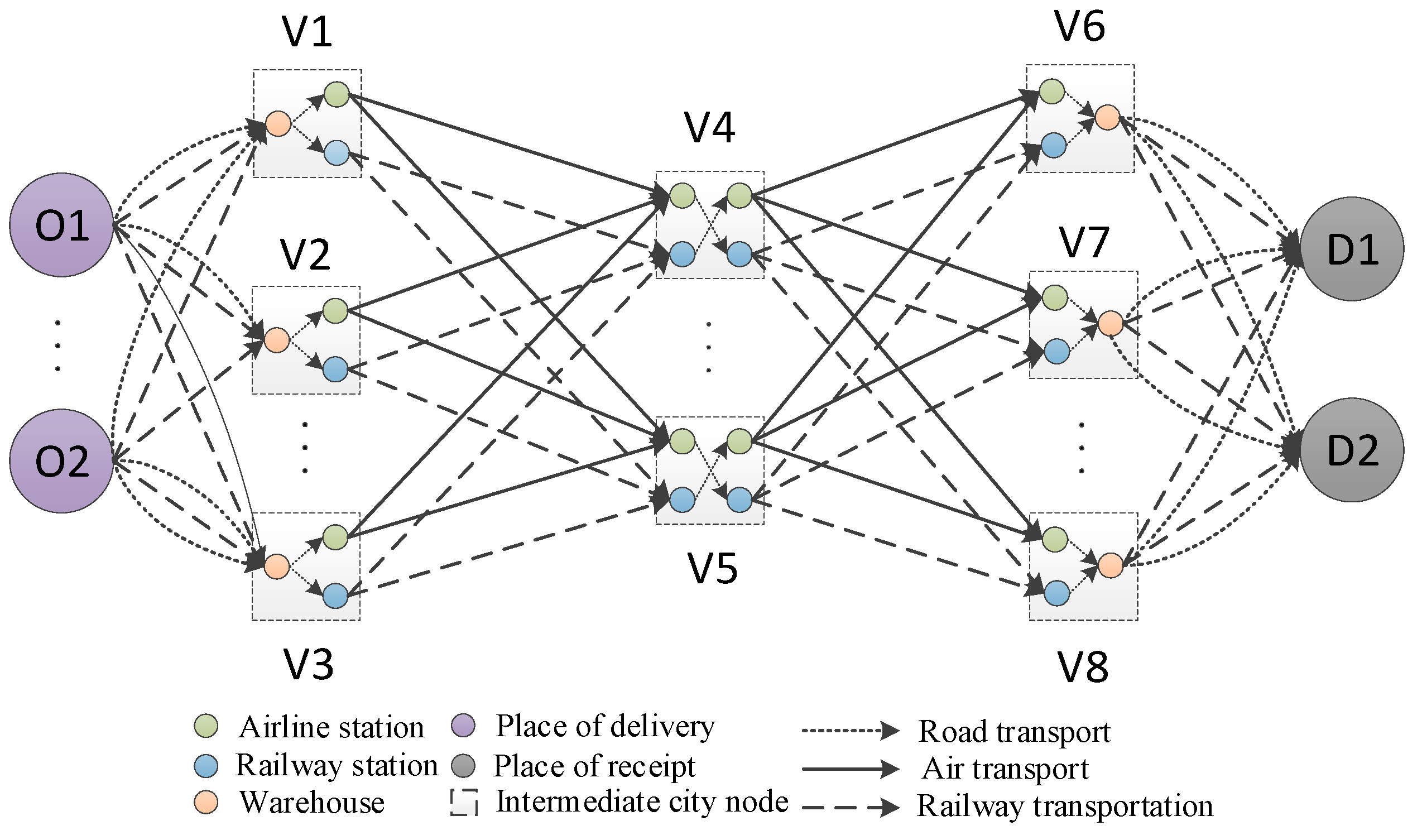
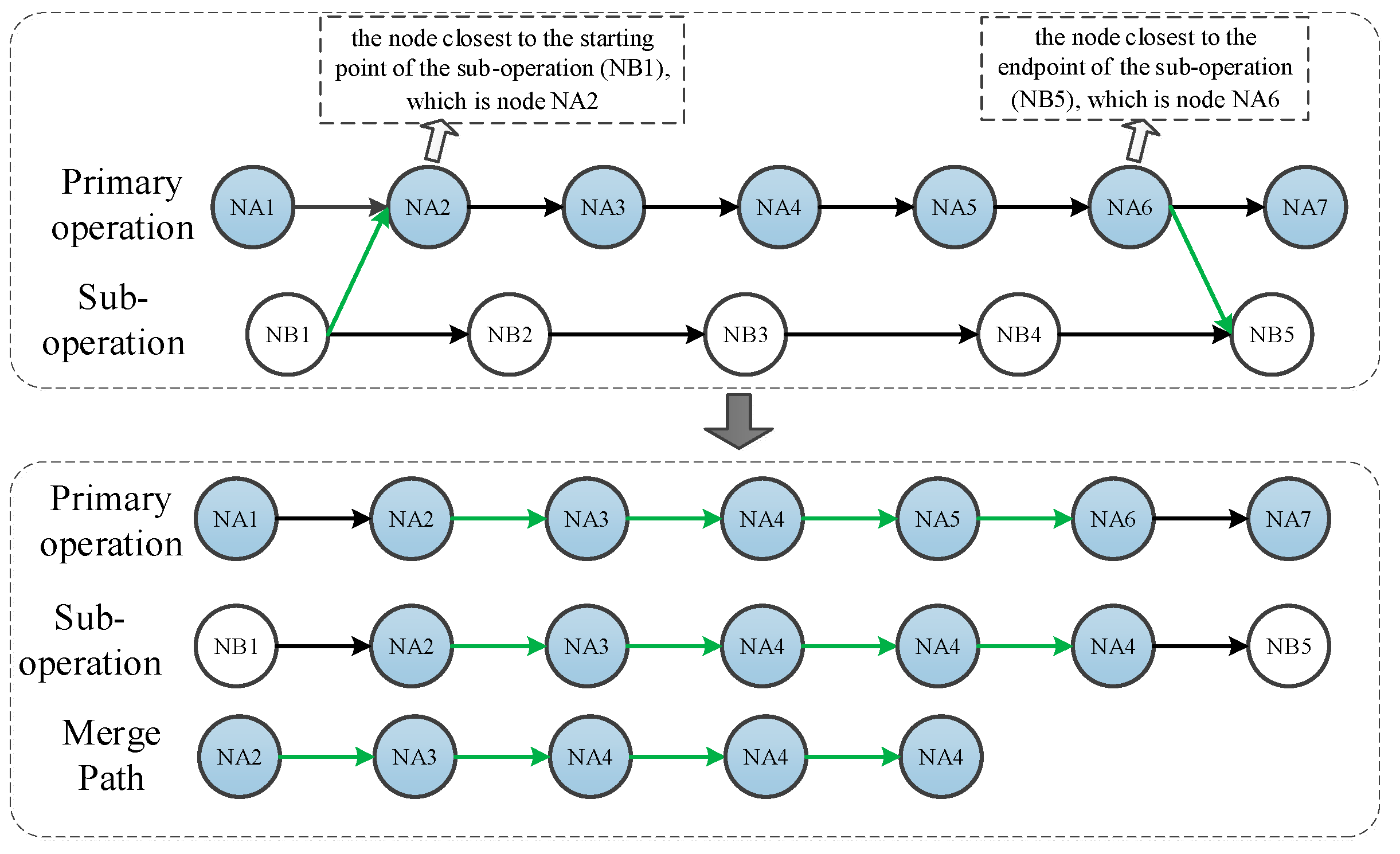




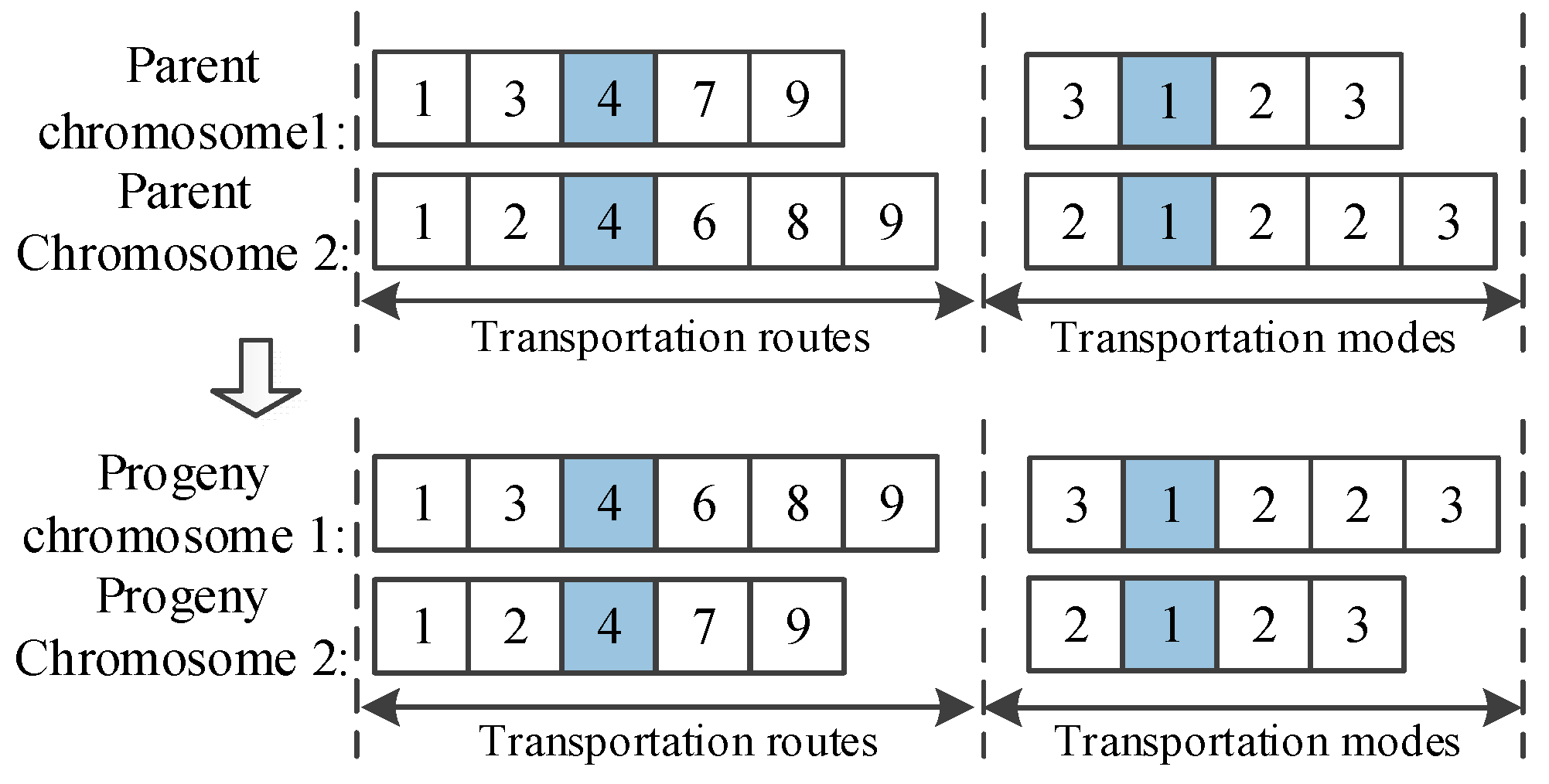



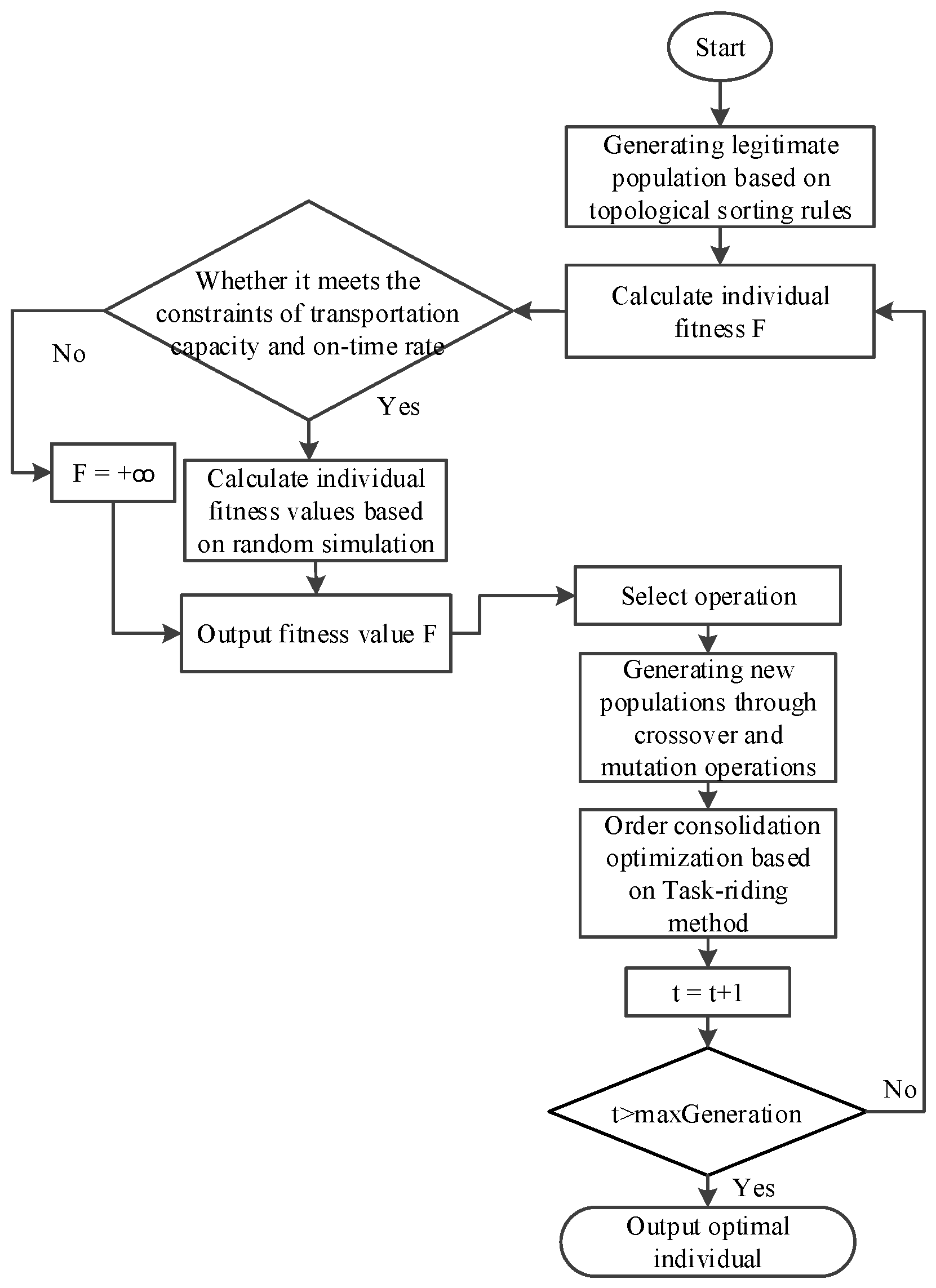

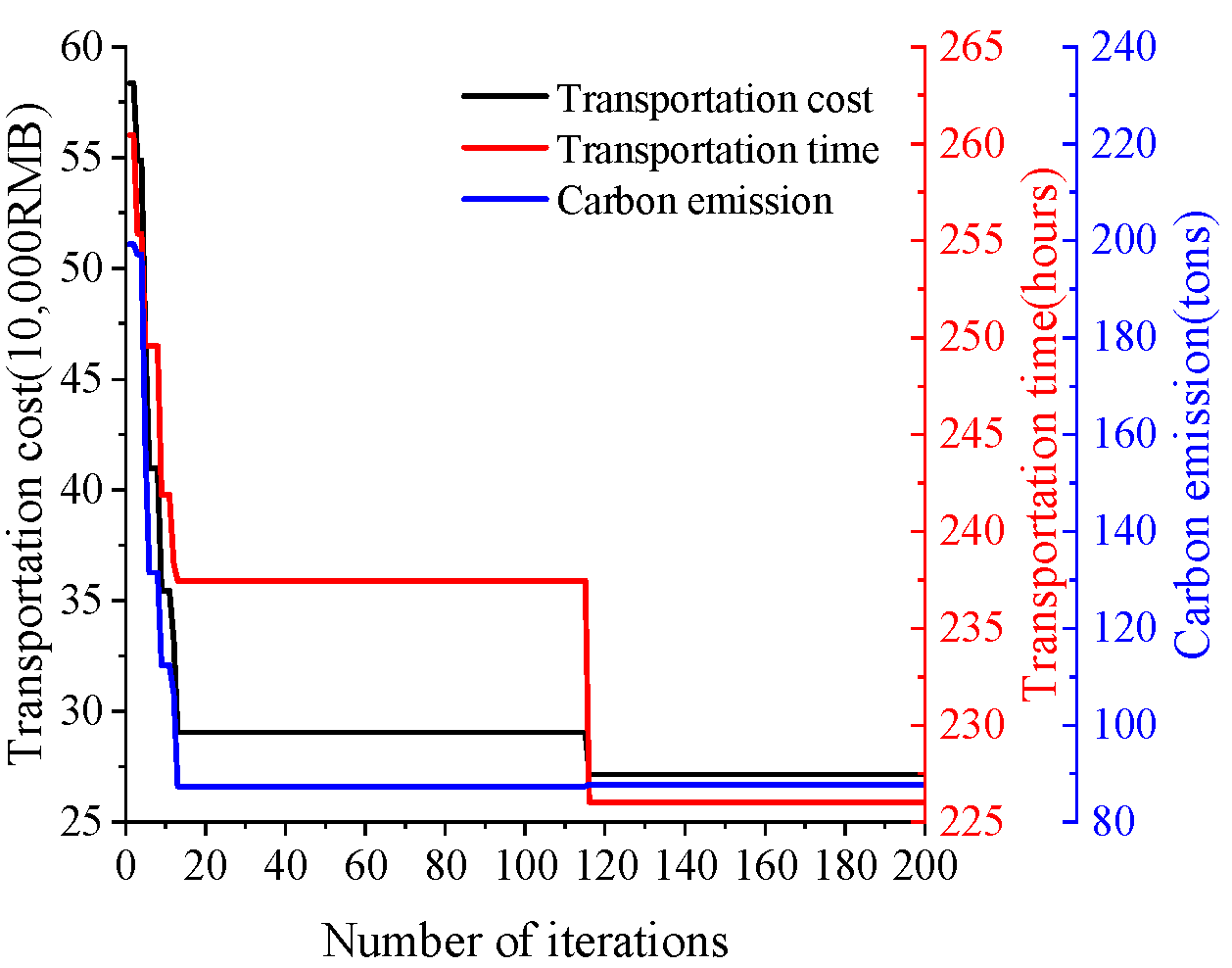

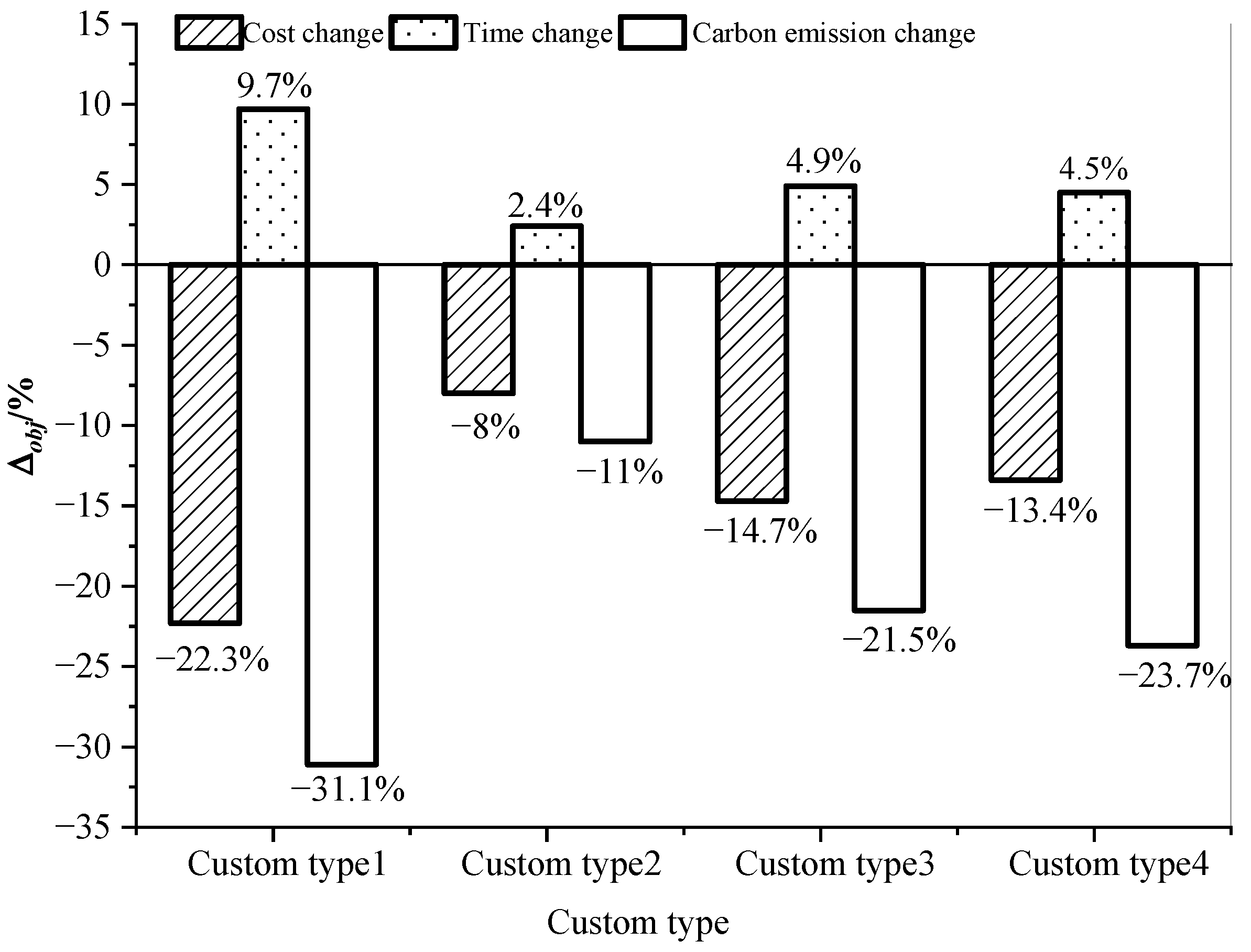
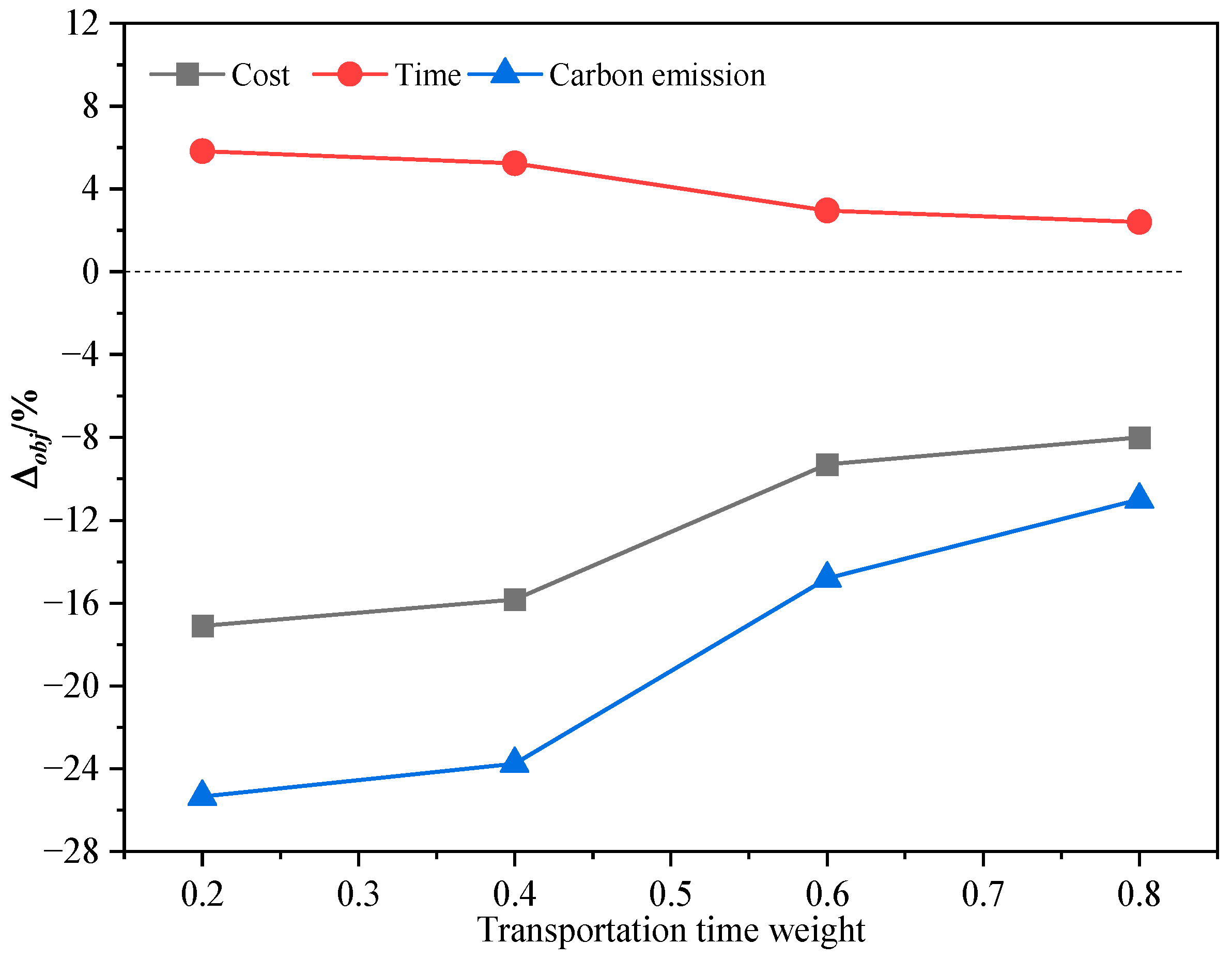


| Set Symbols | Definitions |
|---|---|
| Set of city nodes, where , is the starting point, is the endpoint. | |
| Set of transportation modes, . | |
| Set of transportation arcs between two nodes, . | |
| Set of transportation orders, . | |
| Set of consolidated orders, . | |
| Set of order consolidations, . | |
| Set of unconsolidated orders, where . | |
| Parameter Symbols | Definitions |
| A sufficiently large positive integer. | |
| Total transportation cost. | |
| Total transportation time. | |
| Total carbon emissions. | |
| Fuzzy freight volume of order. | |
| Arrival time at the destination for the order . | |
| Transportation speed of the mode . | |
| Time window constraint of order . | |
| Capacity limitation of transportation mode . | |
| Penalty cost per unit time for late arrival of order beyond the time window. | |
| Storage cost per unit time for early arrival of order before the time window. | |
| Unit transportation cost of the order from node to node using mode . | |
| Fixed cost of using transportation mode . | |
| Unit cost for order transferring from mode to mode at node . | |
| Unit carbon emissions of order from node to node using mode . | |
| Unit carbon emissions for order transferring from mode to mode at node . | |
| Transportation distance between nodes and . | |
| Start time for order . | |
| Determined transportation time of order from node to node using mode . | |
| Uncertain delay time of order from node to node using mode . | |
| Determined transfer time of order from mode to mode at node . | |
| Uncertain delay time of order transferring from mode to mode at node . | |
| Total time for order to travel from start node to node using mode . | |
| Total time for order to reach node and complete transfer from mode to mode . | |
| Departure time of the trip of mode from node to node . | |
| Waiting time for order at node for the next trip of mode . | |
| Number of days order travels to node using mode . | |
| Binary variable indicating whether order uses the trip of mode from node to node (1 if yes, 0 otherwise). | |
| In-transit transportation cost considering order consolidation. | |
| Transportation cost objective function value considering order consolidation. | |
| Unit transportation cost determined by the freight volume grade for mode between node and node . | |
| Lower limit of the freight volume grade for mode between node and node . | |
| Upper limit of the freight volume grade for mode between node and node . | |
| Main order in the consolidated order set. | |
| Sub-order in the consolidated order set. | |
| Consolidation node for main order and sub-orders in the consolidated order set. | |
| Transportation cost of the consolidated order set. | |
| Transportation time of the consolidated order set. | |
| Carbon emissions of the consolidated order set. | |
| Transportation cost of order without consolidation. | |
| Transportation time of order without consolidation. | |
| Carbon emissions of order without consolidation. | |
| Decision Variables | Definitions |
| Binary variable indicating whether order is transported from node to node using mode (1 if yes, 0 otherwise). | |
| Binary variable indicating whether order is transferred from mode to mode at node (1 if yes, 0 otherwise). |
| Input: Transportation scheme |
| Output: The transportation cost, time, and carbon emissions of the scheme |
| 1 Random delay time . |
| 2 Number of random simulations |
| 3 for 4 5 6 7 8 end 9 return ; ; . |
| Input: Set of transportation schemes for each order |
| Output: Combined transportation schemes for orders |
| 1 Set the order to be consolidated as , and the current order set . |
| 2 Set the consolidated order as , and the current order set . 3 Set the unconsolidated orders as , and the current order set |
| 4 while ; |
|
| 6 Update the current set of orders to be consolidated . |
| 7 Select a secondary task from the set of orders to be consolidated. 8 Update the current set of orders to be merged: . |
|
|
| 11 Update the current set of transportation schemes for consolidating: . |
|
| Node-to-Node | Transportation Distance (km) | Node-to-Node | Transportation Distance (km) | ||||
|---|---|---|---|---|---|---|---|
| Airlines | Railroads | Roads | Airlines | Railroads | Roads | ||
| 1-4 | — | 126 | 144 | 7-15 | 1133 | — | — |
| 2-5 | — | 171 | 223 | 7-17 | 1967 | — | — |
| 2-6 | — | 160 | 179 | 7-18 | 2077 | — | — |
| 3-5 | — | 256 | 242 | 8-9 | — | 120 | 145 |
| 3-6 | — | 301 | 309 | 9-12 | 857 | 964 | — |
| 4-7 | 444 | 667 | — | 9-14 | 1130 | 1267 | — |
| 4-9 | 404 | 871 | — | 9-15 | 872 | 948 | — |
| 4-11 | 695 | — | — | 9-17 | 1822 | — | — |
| 4-12 | 1261 | — | — | 9-18 | 1773 | — | — |
| 4-14 | 1576 | — | — | 10-11 | — | 72 | 79 |
| 4-15 | 1254 | — | — | 11-12 | 630 | 695 | — |
| 5-7 | 649 | 741 | — | 11-14 | 887 | 998 | — |
| 5-9 | 974 | 1126 | — | 11-15 | 520 | 536 | — |
| 5-11 | 1339 | 1538 | — | 11-17 | 1389 | — | — |
| 5-12 | 1630 | — | — | 11-18 | 1465 | — | — |
| 5-14 | 1354 | — | — | 12-13 | — | 64 | 73 |
| 5-15 | 1859 | — | — | 12-17 | 1255 | 1804 | — |
| 6-7 | 579 | 963 | — | 12-18 | 1526 | 1707 | — |
| 6-9 | 780 | 1027 | — | 14-17 | 1308 | 1803 | — |
| 6-11 | 988 | 1439 | — | 14-18 | 1343 | 1689 | — |
| 6-12 | 910 | — | — | 15-16 | — | 215 | 240 |
| 6-14 | 1051 | — | — | 15-17 | 873 | 1064 | — |
| 6-15 | 1460 | — | — | 15-18 | 938 | 1184 | — |
| 7-9 | 364 | 277 | — | 17-19 | — | 24 | 35 |
| 7-11 | 690 | 689 | — | 17-20 | — | 78 | 88 |
| 7-12 | 981 | 1160 | — | 18-19 | — | 161 | 152 |
| 7-14 | 1178 | 1463 | — | 18-20 | — | 81 | 144 |
| Node-to-Node | Capacity Constraint (Tons) | Node-to-Node | Capacity Constraint (Tons) | ||||
|---|---|---|---|---|---|---|---|
| Airlines | Railroads | Roads | Airlines | Railroads | Roads | ||
| 1-4 | — | 30 | 35 | 7-15 | 60 | 50 | — |
| 2-5 | — | 35 | 45 | 7-17 | 55 | 50 | — |
| 2-6 | — | 40 | 35 | 7-18 | 55 | 55 | — |
| 3-5 | — | 35 | 30 | 8-9 | — | 40 | 35 |
| 3-6 | — | 45 | 40 | 9-12 | 50 | 45 | — |
| 4-7 | 50 | 55 | — | 9-14 | 55 | 50 | — |
| 4-9 | 45 | 50 | — | 9-15 | 60 | 55 | — |
| 4-11 | 55 | — | — | 9-17 | 55 | 50 | — |
| 4-12 | 40 | — | — | 9-18 | 50 | 50 | — |
| 4-14 | 45 | — | — | 10-11 | — | 35 | 35 |
| 4-15 | 50 | — | — | 11-12 | 55 | 50 | — |
| 5-7 | 50 | 45 | — | 11-14 | 60 | 55 | — |
| 5-9 | 45 | 55 | — | 11-15 | 55 | 50 | — |
| 5-11 | 45 | 50 | — | 11-17 | 50 | 50 | — |
| 5-12 | 40 | 40 | — | 11-18 | 50 | 45 | — |
| 5-14 | 50 | 45 | — | 12-13 | — | 40 | 35 |
| 5-15 | 50 | 55 | — | 12-17 | 55 | 55 | — |
| 6-7 | 55 | 50 | — | 12-18 | 50 | 50 | — |
| 6-9 | 50 | 45 | — | 14-17 | 60 | 55 | — |
| 6-11 | 55 | 50 | — | 14-18 | 55 | 50 | — |
| 6-12 | 45 | 40 | — | 15-16 | — | 35 | 35 |
| 6-14 | 50 | 45 | — | 15-17 | 60 | 55 | — |
| 6-15 | 50 | 50 | — | 15-18 | 55 | 55 | — |
| 7-9 | 55 | 55 | — | 17-19 | — | 40 | 35 |
| 7-11 | 60 | 55 | — | 17-20 | — | 40 | 35 |
| 7-12 | 55 | 50 | — | 18-19 | — | 45 | 40 |
| 7-14 | 60 | 55 | — | 18-20 | — | 50 | 45 |
| Order Number | Origin | Destination | Dispatch Time | Delivery Deadline (Hours) | Fuzzy Freight Weight (Tons) |
|---|---|---|---|---|---|
| Or1 | Wulanchabu | Dongguan | 9:00 | 11–32 | [7,12,14,19] |
| Or2 | Wulanchabu | Zhenjiang | 12:00 | 10–33 | [3,7,9,14] |
| Or3 | Yingkou | Dongguan | 10:00 | 12–32 | [5,10,12,17] |
| Or4 | Yingkou | Zhenjiang | 8:00 | 10–30 | [4,9,11,16] |
| Or5 | Dandong | Foshan | 8:00 | 12–32 | [6,11,13,18] |
| Or6 | Dandong | Yueyang | 10:00 | 12–30 | [3,8,10,15] |
| Or7 | HengShui | Dongguan | 11:00 | 10–21 | [4,8,9,14] |
| Or8 | HengShui | Yueyang | 7:00 | 10–18 | [2,6,7,12] |
| Or9 | Kaifeng | Foshan | 9:00 | 10–20 | [2,6,8,13] |
| Or10 | Kaifeng | Dongguan | 6:00 | 10–18 | [3,7,8,13] |
| Order Number | Scenario 1 | Scenario 2 | Scenario 3 | Scenario 4 | ||||
|---|---|---|---|---|---|---|---|---|
| Origin | Destination | Origin | Destination | Origin | Destination | Origin | Destination | |
| Or1 | Yingkou | Dongguan | Yingkou | Dongguan | Wulanchabu | Dongguan | Wulanchabu | Dongguan |
| Or2 | Yingkou | Dongguan | Yingkou | Zhenjiang | Wulanchabu | Dongguan | Wulanchabu | Zhenjiang |
| Or3 | Yingkou | Dongguan | Yingkou | Dongguan | Yingkou | Dongguan | Yingkou | Dongguan |
| Or4 | Yingkou | Dongguan | Yingkou | Zhenjiang | Yingkou | Dongguan | Yingkou | Zhenjiang |
| Or5 | Yingkou | Dongguan | Yingkou | Foshan | Dandong | Dongguan | Dandong | Foshan |
| Or6 | Yingkou | Dongguan | Yingkou | Yueyang | Dandong | Dongguan | Dandong | Yueyang |
| Or7 | Yingkou | Dongguan | Yingkou | Dandong | HengShui | Dongguan | Hengshui | Dandong |
| Or8 | Yingkou | Dongguan | Yingkou | Yueyang | HengShui | Dongguan | Hengshui | Yueyang |
| Or9 | Yingkou | Dongguan | Yingkou | Foshan | Kaifeng | Dongguan | Kaifeng | Foshan |
| Or10 | Yingkou | Dongguan | Yingkou | Dongguan | Kaifeng | Dongguan | Kaifeng | Dandong |
| Transportation Method | Air | Railway | Road |
|---|---|---|---|
| Average Speed (km/h) | 800 | 280 | 85 |
| Fixed Cost (RMB per trip) | 966 | 622 | 483 |
| Unit Cost (RMB per ton·km) | 3.1 | 0.59 | 0.52 |
| Unit Carbon Emission (kg per ton·km) | 1.271 | 0.157 | 0.266 |
| Transportation Method | Departure Times |
|---|---|
| Air | 1:00; 5:00; 11:00; 21:00; |
| Railway | 2:00; 4:00; 6:00; 10:00; 16:00; 20:00; 23:00 |
| Transfer Type | Air-Railway | Air-Road | Railway-Road |
|---|---|---|---|
| Unit Transfer Cost (RMB/ton) | 10 | 8 | 5.5 |
| Unit Transfer Time (hours/ton) | 0.7 | 0.5 | 0.2 |
| Unit Transfer Carbon Emission (kg/ton) | 4.33 | 5.56 | 3.24 |
| Delay Time Interval (Hours) | Mean | Variance | Delay Probability | ||
|---|---|---|---|---|---|
| In-Transit | Air | [0, 3] | 2.15 | 0.51 | 0.4 |
| Railway | [0, 3] | 1.25 | 0.45 | 0.1 | |
| Transfer | Air–Railway | [0, 3] | 2.54 | 0.31 | 0.3 |
| Without Consolidation | With Consolidation | |||||
|---|---|---|---|---|---|---|
| Order Number | Cost (10,000 RMB) | Time (Hours) | Carbon Emission (Tons) | Cost (10,000 RMB) | Time (Hours) | Carbon Emission (Tons) |
| Or1 | 5.3402 | 28.70 | 17.84 | 2.5020 | 31.73 | 5.07 |
| Or2 | 4.3804 | 16.16 | 16.41 | 4.0 | 32.73 | 12.04 |
| Or3 | 3.1272 | 31.37 | 7.38 | 1.748 | 22.42 | 3.88 |
| Or4 | 3.8990 | 15.95 | 14.41 | 3.217 | 29.10 | 15.79 |
| Or5 | 3.3254 | 31.35 | 7.52 | 3.6889 | 20.39 | 11.38 |
| Or6 | 5.5071 | 13.59 | 22.14 | 1.0774 | 28.10 | 1.85 |
| Or7 | 6.0428 | 12.95 | 23.76 | 1.5418 | 20.82 | 3.14 |
| Or8 | 0.7831 | 12.21 | 2.06 | 0.7237 | 14.27 | 1.61 |
| Or9 | 1.2820 | 19.39 | 2.48 | 4.2846 | 11.85 | 16.61 |
| Or10 | 1.2715 | 18.25 | 2.60 | 4.3736 | 14.63 | 16.43 |
| In total | 34.9587 | 199.92 | 116.60 | 27.157 | 226.04 | 87.8 |
| — | — | — | −16.6% | 5.56% | −24.69% | |
| Customer Types | Transportation Cost, Time, Carbon Emissions |
|---|---|
| Customer Type 1: Price-Sensitive | 0.8, 0.1, 0.1 |
| Customer Type 2: Time-Sensitive | 0.1, 0.8, 0.1 |
| Customer Type 3: Time and Price-Sensitive | 0.45, 0.45, 0.1 |
| Customer Type 4: Time and Carbon Emission-Sensitive | 0.1, 0.45, 0.45 |
Disclaimer/Publisher’s Note: The statements, opinions and data contained in all publications are solely those of the individual author(s) and contributor(s) and not of MDPI and/or the editor(s). MDPI and/or the editor(s) disclaim responsibility for any injury to people or property resulting from any ideas, methods, instructions or products referred to in the content. |
© 2024 by the authors. Licensee MDPI, Basel, Switzerland. This article is an open access article distributed under the terms and conditions of the Creative Commons Attribution (CC BY) license (https://creativecommons.org/licenses/by/4.0/).
Share and Cite
Zhu, P.; Lv, X.; Shao, Q.; Kuang, C.; Chen, W. Optimization of Green Multimodal Transport Schemes Considering Order Consolidation under Uncertainty Conditions. Sustainability 2024, 16, 6704. https://doi.org/10.3390/su16156704
Zhu P, Lv X, Shao Q, Kuang C, Chen W. Optimization of Green Multimodal Transport Schemes Considering Order Consolidation under Uncertainty Conditions. Sustainability. 2024; 16(15):6704. https://doi.org/10.3390/su16156704
Chicago/Turabian StyleZhu, Pei, Xiaolong Lv, Quan Shao, Caijin Kuang, and Weiwang Chen. 2024. "Optimization of Green Multimodal Transport Schemes Considering Order Consolidation under Uncertainty Conditions" Sustainability 16, no. 15: 6704. https://doi.org/10.3390/su16156704





